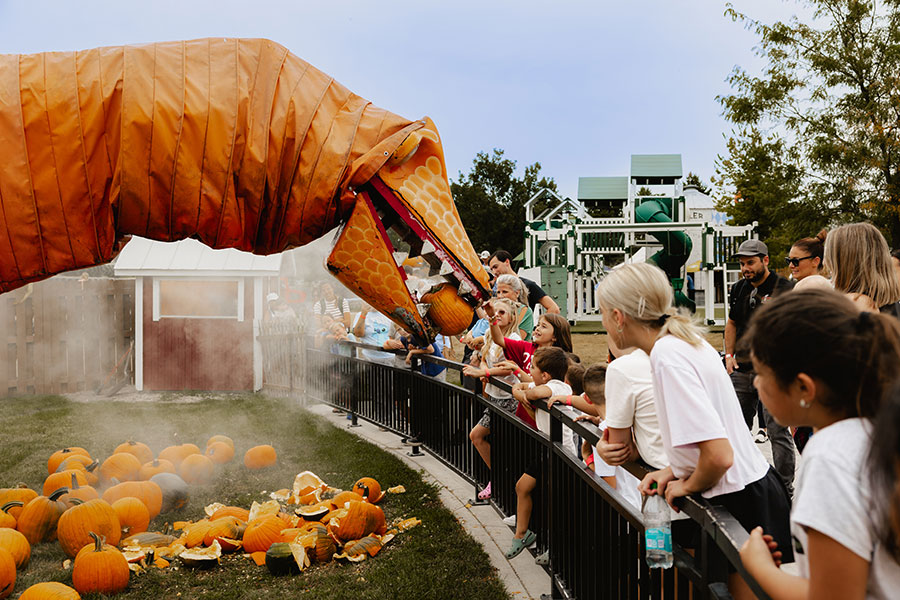Pumpkins are the symbol of autumn. The season has just begun, but they’re already everywhere you look. Pumpkins spice lattes at Starbucks. Pumpkin spice-flavored Frosted Flakes. Pumpkin cookies. Pumpkin filling for pies. Pumpkin soup. Pumpkin ice cream. Pumpkins in the produce section of the supermarket, their orange skins brightening a table full of gourds. Pumpkins on grammar school decorations. It’s the Great Pumpkin, Charlie Brown on television. And as Halloween approaches, we’ll see pumpkins on porches and in windows, carved into jack o’ lanterns.
Where are all these pumpkins coming from? From right here in Illinois, which grows far more pumpkins than any other state, and it’s not even close. In a recent year, Illinois grew 634 million pounds of pumpkins, making it a $200 million industry in the state. In second place? Indiana, with 161 million pounds.
“We are not only No. 1 in production, we are about three times as big as those other states,” says Mohammed Babadoost, a plant pathology professor at the University of Illinois, and the state’s leading pumpkin expert. “We are truly the pumpkin state.”
Why Illinois? The soil is rich here, and the land is flat, making it ideal for pumpkin patches. Also, the state has a moderate climate. Pumpkins thrive in the summer, but too much heat stunts their growth. Farmers call this midland region “the orange belt.” For that reason, the world’s largest pumpkin processing plant, Nestle Libby, is in Morton, a small town near Peoria. Morton, which calls itself the Pumpkin Capital of the World, holds an annual Pumpkin Festival. Libby’s and another nearby plant, Seneca Foods Processing in Princeville, produce more than 90 percent of the nation’s canned pumpkin, an industry that started in Illinois in 1925. Each year, the state produces enough pumpkins to bake 48 million pies. That’s a pie for every third household in the United States.
“If there is no Illinois, there is no pumpkin pie,” says Babadoost.
About half of the 25,000 acres under cultivation in the state grow pumpkins for canning. The rest grow pumpkins for jack o’ lanterns.
“Pumpkin is not just for Halloween or pie,” says Babadoost. “Pumpkin is for recreation. Lots of people visit pumpkin patches for fun or education.”
In the Chicago area, one of the biggest pumpkin patches is at Goebbert’s Farm in Pingree Grove, just west of Elgin. Goebbert’s is a full-service fall entertainment center, with a petting zoo containing llamas and alpacas, a giraffe on loan from a zoo in the Wisconsin Dells, a haunted mansion, pony rides, and — for grown ups — a beer stand serving pumpkin lager. There’s also a billboard with pumpkin facts: pumpkins have been grown in North America for 5,000 years; the largest pumpkin ever grown in the U.S. weighed 2,528 pounds. But the No. 1 attraction is pumpkin picking on a few of the 100 acres set aside for cultivation.
“People love Chicago because of the spring and the fall,” says Jake Goebbert, grandson of James Goebbert, who founded the farm to provide pumpkins to Jewel and Meijer. “We deal with the winters. In Illinois, Halloween is second to Christmas. Everybody realizes it’s their last chance to be outside. October is the largest part of our business.”
(Some other big pumpkin players in the area include Bengtson’s Farm in Homer Glen, Royal Oak Farm Orchard in Harvard, and All Seasons Orchard in Woodstock.)
Goebbert took me on a ride out to the pumpkin patch. Along the way, he speculated on why pumpkins are synonymous with autumn. He couldn’t come up with a good reason.
“Obviously, it is a fall crop,” he said. “The question of why pumpkins are the staple of fall is a mystery.”
Mystery or not, it’s a fact that it’s not fall without a pumpkin. Get one soon. Goebbert’s close to the public on Halloween, the peak of every year’s pumpkin season.



